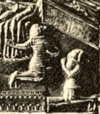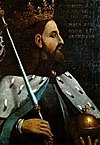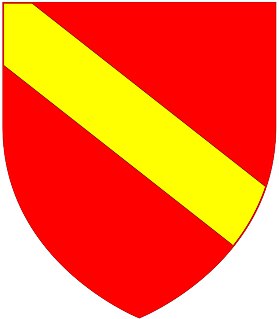
The Vojislavljević was a Serbian medieval dynasty, named after archon Stefan Vojislav, who wrested the polities of Duklja, Travunia, Zahumlje, inner Serbia and Bosnia from the Byzantines in the mid-11th century. His successors, kings Mihailo I Vojislavljević and Constantine Bodin expanded and consolidated the state. During the 12th century, the main line of the Vojislavljević family was ousted by their cadet branch, the Vukanović, in the late 12th century.

Bosnia is the northern region of Bosnia and Herzegovina, encompassing roughly 81% of the country; the other region, the southern part, is Herzegovina.
Eudokia Angelina was the consort of Stefan the First-Crowned of Serbia from c. 1190 to c. 1200. She later remarried, to Alexios V Doukas, who briefly ruled as Emperor of Byzantium in 1204. She was a daughter of Alexios III Angelos and Euphrosyne Doukaina Kamatera.
Thessalonica in the Middle Ages may refer to the city Thessalonica,, Thessalonica (theme) or to the Latin Kingdom of Thessalonica.

Usora was important zemlja of the medieval Bosnian state, first banate and later kingdom, although it also had some periods outside its jurisdiction and royal authority, when it was connected with neighboring banates of Slavonia, or Mačva at times. The administrative seat of this zemlja was Srebrenik, which also served as residence for its rulers for entire period of existence of the medieval Bosnian state. It took its name from the river Usora.
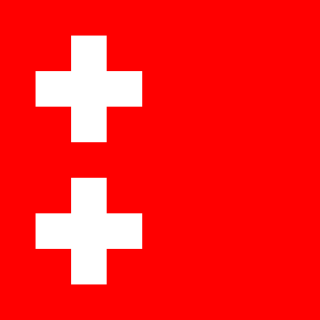
Duchy of Saint Sava was a late medieval polity in southeastern Europe, that existed from 1448 up to 1482, when it was absorbed by the Ottoman Empire. It was ruled by the Kosača noble family, who held the title "Duke of Saint Sava". Their domains included southern parts of modern-day Bosnia and Herzegovina, extending to southern parts of modern-day coastal Croatia, northwestern Montenegro and southwestern Serbia. Its founder, Stjepan Vukčić Kosača, titled himself Herceg of Saint Sava, a title which would later give rise to the new name to the region: Herzegovina, and will be also used by the Ottomans as Hersek Sancağı, designating the Sanjak of Herzegovina.

Pomorje, also known as the Lands of Pomorje, is a medieval term, used to designate several maritime regions of Upper Dalmatia and its hinterland, that at the end of the 12th century, during the reign of Stefan Nemanja (1166–1196), became part of the Grand Principality of Serbia, and remained part of the medieval Kingdom of Serbia, whose rulers were styled with the title: "crowned king and autocrat of all Serbian and coastal lands".
Michael of Bosnia, Duke of Bosnia from 1262 to 1266, was a member of the Rurik dynasty.
Bran Mutimirović was a Serbian prince, son of Serbian ruler Mutimir.
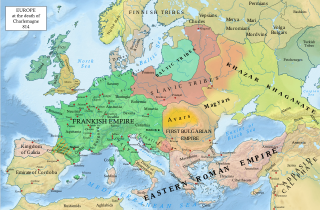
Radoslav was a Serbian Prince who ruled over the early medieval Principality of Serbia at the beginning of the 9th century. He succeeded his father, prince Višeslav, who ruled at the end of the 8th century. Radoslav was succeeded by his son, prince Prosigoj.
The "Lands of the Hungarian Crown" was the titular expression of Hungarian pretensions to the various territories that the King of Hungary ruled nominally or absolutely.
Stefan Mutimirović was a 9th-century Serbian royal member of the ruling dynasty, the Vlastimirović.
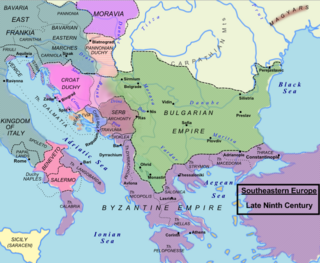
The Duchy of Croatia was a medieval state that was established in the former Roman province of Dalmatia. Throughout its time it had several seats – namely, Klis, Solin, Knin, Bijaći and Nin. It comprised the littoral – the coastal part of today's Croatia – except Istria, and included a large part of the mountainous hinterland as well. The duchy was in the center of competition between the Carolingian Empire and the Byzantine Empire for rule over the area. Rivalry with Venice emerged in the first decades of the 9th century and was to continue for the following centuries. Croatia also waged battles with the Bulgarian Empire, with whom the relations improved greatly afterwards, and the Arabs and sought to extend its control over important coastal cities under the rule of Byzantium. Croatia experienced periods of vassalage to the Franks or Byzantines and de facto independence until 879, when Duke Branimir was recognized as an independent ruler by Pope John VIII. The duchy was ruled by the Trpimirović and Domagojević dynasties. Around 925, during the rule of Tomislav, Croatia became a kingdom.

Soli or Só was a zemlja of the medieval Bosnian state, located in today's northern Bosnia and Herzegovina, centered around the town of Tuzla. Initially, a Slavic župa, the County of Soli became an integral part of Kulin's Bosnia and later both of Banate of Bosnia and of the Kingdom of Bosnia. The meaning of the name is "salts". With the arrival of the Ottoman Empire around 1512, the names of the villages "Gornje Soli" and "Donje Soli" were translated to "Memlehai-bala" and "Memlehai-zir", literally meaning Upper and Lower Saltworks, resp.
John V. A. Fine Jr. is an American historian and author. He is professor of Balkan and Byzantine history at the University of Michigan and has written several books on the subject.
Milica Branković was a Serbian princess and the first wife of Leonardo III Tocco, whom she married on 1 May 1463. She was a daughter of despot Lazar Branković of Serbia and Helena Palaiologina. Milica died in childbirth in 1464, while giving birth to Carlo III Tocco. Carlo III Tocco succeeded his father as titular ruler of Epirus (Arta) and Zakynthos. Her siblings were Maria, wife of King Stephen Tomašević of Bosnia and Jerina, wife of Gjon Kastrioti II.

The Eparchy of Dalmatia is a diocese or eparchy of the Serbian Orthodox Church, having jurisdiction over the region of Dalmatia, in Croatia. Since 2017, Serbian Orthodox Bishop of Dalmatia is Nikodim Kosović.

The Syrmia County was an administrative unit (county) of the medieval Kingdom of Hungary in the Middle Ages. It was established in the 13th century, and included most of what is today Serbian Syrmia. It was subordinated to the Banate of Macsó. It was conquered by the Ottomans in 1526.
Radin, known under his full name as Radin Butković, was a clergyman who served as gost of Bosnian Church during the 15th century in medieval Bosnia.

Valkó County was an administrative unit (county) of the medieval Kingdom of Hungary. It was established in the 13th century, and included most territories of the present day Vukovar-Syrmia County, in modern Croatia, and western parts of the present day Syrmia District, in modern Serbia. The most important cities of the county were Vukovar and Ilok. Its territory was conquered by the Ottoman Turks in the first half of the 16th century.




